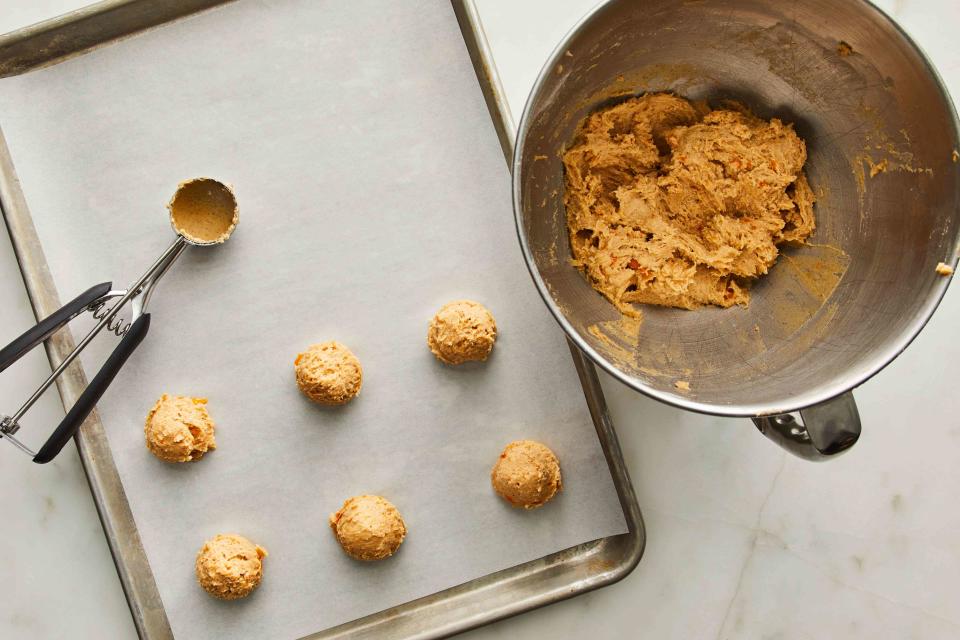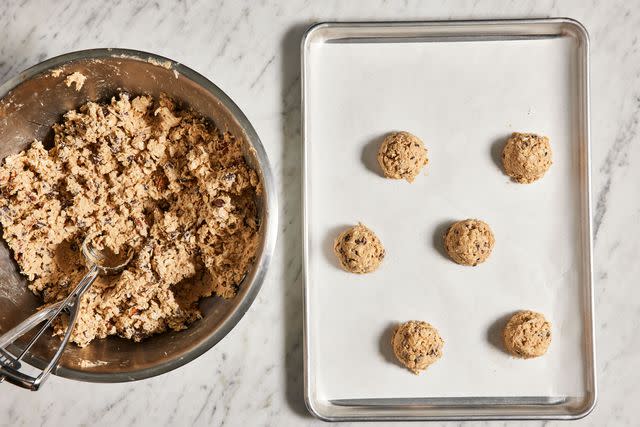Baking Pan Vs. Cookie Sheet: What's The Difference?
And are they interchangeable?

Alison Miksch; Food Stylist: Karen Rankin; Prop Stylist: Josh Hoggle
Whether you need to replace that one pan that has seen better days (you know the one…) or you're looking to expand your baking equipment, having a quality piece of cookware to take care of your baking needs is a must for every kitchen.
Baking pans and cookie sheets are often considered the same, but there are distinct differences between the two that can make a significant difference depending on your baking needs. Both are made for specific purposes, but it can be helpful to know the differences in case you are looking to bake a particular recipe.
What Are Baking Pans?
Baking pans, also known as sheet pans and jelly roll pans, have a flat surface with a one-inch high edge around the sides of the entire pan. With these raised edges, baking a loose batter (like Texas Sheet Cake) or softer dough makes this a clean and practical choice for baking. The edge also helps keep any toppings or crumbs from falling off the edge into your oven.
These pans can be used for nearly all baked goods, including cookies; they can also be used in the kitchen for savory cooking, such as roasting vegetables.
Baking pans come in several different sizes:
Full Sheet (26"x18") – This size is usually too large for home cooking and is more commonly found in commercial kitchens and bakeries.
Half Sheet (18"x13") – Often considered a standard size for home bakers and is the perfect size for home kitchens and most standard ovens.
Quarter Sheet (13" x 9") – A smaller version that is perfect for convection ovens and toaster ovens. This size is ideal for doing personal baking or smaller batches of a recipe.
Jelly Roll Pan (15"x10") – Named after the dessert of the same name, this pan is made specifically for creating jelly roll cakes. (A jelly roll cake is a thin cake baked, then layered with jelly, and rolled into a charming round loaf cake.)
It is worth noting that with the higher edges around the pan, the airflow and heat circulating the baked item are not as efficient compared to a cookie sheet. To work around this issue, keep an eye on your baked goods and consider adjusting the time slightly by increasing the bake time a minute or two.

Jen Causey; Food Stylist: Ruth Blackburn; Prop Stylist: Josh Hoggle
What Are Cookie Sheets?
Cookie sheets feature a large sheet, commonly with one edge on the side for use as a handle for gripping and picking up the pan. They are designed with minimal edges to easily slide cookies off the baking pan without breaking the cookie.
Compared to baking pans, these pans have more limitations because the surface is entirely flat. Any baked good that starts baking with a softer batter, like brownies or cakes, would create a giant mess without the support of edges around the entire pan.
While they aren't the most versatile option for the kitchen, when baking cookies, cookie sheets are hard to beat. Without the edges on the pan, the air can flow better, which creates more consistency and can help prevent crisp edges or excessive browning.
Insulated Cookie Sheets
If you are planning on making more delicate cookies (such as meringues or shortbread), you may want to consider an insulated cookie sheet. These are made with two layers of metal with an open layer between which insulates the air. This can help with more even baking and to help avoid hot spots. This design encourages a slower cook time and a consistent bake for the cookies.
What Do Baking Pans and Cookie Sheets Have in Common?
Baking pans and cookie sheets have notable similarities, one being the materials in which they are commonly found. The most popular pans and sheets are made with aluminum, which is a great conductor of heat, meaning they are fast to heat up in the oven and quick to cool down in case you need to use the same pan for multiple batches of baking.
Aluminum pans are often less expensive, too, which can be great when purchasing essentials for the kitchen without breaking the bank. Other materials that baking pans and cookie sheets can be made with are stainless steel, ceramic, cast iron, and metals with a nonstick coating.
Nearly all these pans have a threshold for heat up to 500 degrees Fahrenheit; temperatures higher than this could cause the pans to warp or be ruined completely. Many pans, especially ones with a nonstick coating, are best hand-washed and should not be put in the dishwasher.
Using parchment paper or a silicone mat when baking can also help extend the life of your pan and help make cleanup easier.
Related: The 13 Best Silicone Baking Mats for Mess-Free Cooking
How to Choose Which One Is Right for You
Choosing which piece of equipment is right for you depends on what you feel you would need most in your kitchen. If you are looking for a versatile option, a baking pan can cover most baking projects and can be a great piece of equipment for your cooking projects in the kitchen. When in doubt, it is helpful to use the type of equipment specified in your favorite recipe for the best results.
Related: 84 Best Cookies And Bars To Fill Your Cookie Jars
For more Southern Living news, make sure to sign up for our newsletter!
Read the original article on Southern Living.

